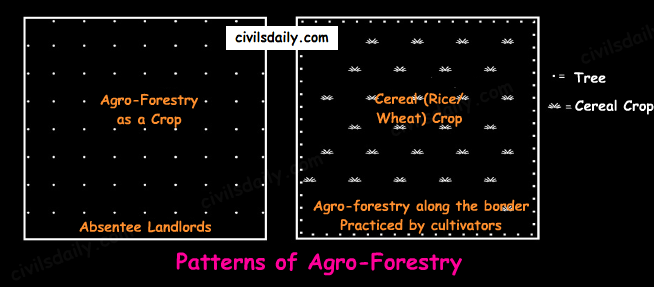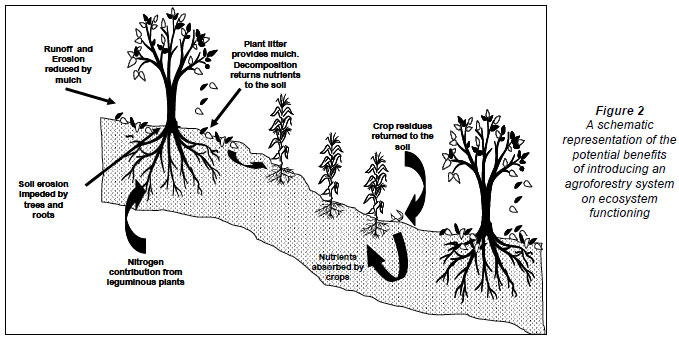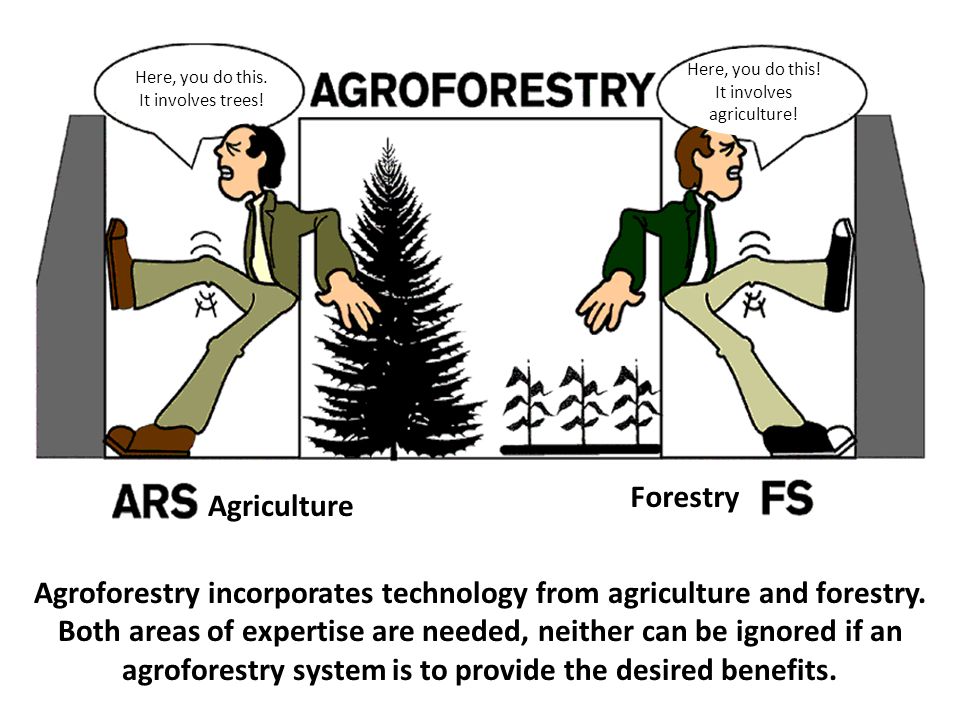What is Agroforestry?
Agroforestry is a sustainable management mechanism for land that:
- increases overall production,
- combines agricultural crops, tree crops, forest plants and animals simultaneously, and
- applies management practices that are compatible with cultural practices of the local population.
It is a type of social forestry in which an individual farmer undertakes tree farming and grows fodder plants, grasses and legumes on his own land. In agroforestry trees are considered a crop and become a part of crop combinations.

There is an increasing number of farmers who plant trees either along the boundaries or in the whole field/farm as a crop. In fact, in the northern plains of India, trees are planted by most of the farmers irrespective of the size of their holdings. The large farmers and absentee landlords generally put a part of their holdings or total agricultural area under tree crops.
The main advantage of agroforestry is considered to be its positive impact on the soil. Let’s understand the impact of trees on the soil.
How trees improve soils:
- Litter or Mulch:
During the lifetime of a tree, leaves, twigs and branches die and fall to the ground as litter. Litter contributes to the organic-matter content of the soil after it decomposes. A soil that is rich in organic matter has a better capacity to absorb and retain water and thus is also more resistant to erosion. A good cover of litter or mulch can also be very effective in suppressing weeds.
2. Increase nutrient content of soil:
- Nutrient Uptake from deeper layers of soil: Tree roots normally penetrate deeper into the soil than the roots of crops. Though not experimentally verified, trees are generally considered more efficient than crops in taking up nutrients released by weathering deep in the soil.
- Nutrients from the atmosphere: The presence of a tree reduces the wind speed and creates good conditions for the deposition of dust. Nutrients in the atmosphere are conveyed to the soil when they are dissolved in rain or settle with dust. Rain water dripping from leaves and flowing along the branches carries the nutrients to the ground, together with those released from the tree itself and associated plants growing on it. It is known that the amounts of nutrients reaching the ground in this way are substantial.
- Nitrogen Fixation: Many leguminous trees and a few non-leguminous ones have the ability to fix atmospheric nitrogen through symbiosis with bacteria or fungi in root nodules. The fixation of nitrogen has been proven and found to be a significant factor in soil fertility. Also, the litter from nitrogen-fixing plants is often rich in nitrogen which is added to the soil when the litter or mulch decomposes.
3. Protection from soil erosion
Tree roots and stems reduce surface run-off, nutrient leaching and soil erosion.
Source
Some Other Benefits of Agroforestry:
1. Environmental Benefits:
- Reduction of pressure on natural forests. It is also recognized that Agroforestry is perhaps the only alternative to meeting the target of increasing forest or tree cover to 33 percent from the present level of less than 25 per cent, as envisaged in the National Forest Policy (1988).
- Agroforestry is known to have the potential to mitigate the climate change effects through:
- microclimate moderation and natural resources conservation in the short run, and
- carbon sequestration in the long run. Agroforestry species are known to sequester as much carbon in below-ground biomass as the primary forests, and far greater than the crop and grass systems.
- When strategically applied on a large scale, with an appropriate mix of species, agro-forestry enables agricultural land to withstand extreme weather events, such as floods and droughts, and climate change.
2. Economic benefits:
- A greater output of food, fuel wood, fodder and timber.
- Increase in levels of farm income due to improved and sustained productivity.
- Agroforestry leads to a reduction in the incidence of total crop failure, which is common to single cropping or monoculture systems. This is because such systems are structurally and functionally more complex than monoculture.
- The absentee landlords go for agroforestry to retain the title of the land and to increase their income. It provides an alternative to land owners to manage their agricultural land in absence of family labour.
- Agroforestry has significant potential to provide employment to the rural and urban population through production, industrial application and value addition ventures. Current estimates show that about 65 % of the country’s timber requirement is met from the trees grown on farms.
3. Social benefits :
- Improvement in rural living standards from sustained employment and higher income.
- Makes the villagers self-dependent at the village-level.
Despite the numerous material and geo-climatic benefits, agroforestry if not carefully planned can have some adverse effects on agricultural land. Some of these are:
- In the fields along which trees have been planted, the productivity per unit area decreases, as in at least about two meters from the trees the moisture content in the soil is significantly reduced. Also, the combination of trees and crops must be so chosen so as to minimise the competition between their roots for moisture.
- Unscientific planning can also negatively impact the agricultural productivity of the land. E.g. growing trees with photophilic i.e. light-loving plants.
- Pests and Diseases: Mixtures of trees and crops make a more diverse environment than monocropping. A diverse environment enables a greater variety of species of all kinds of organisms — both desirable and less desirable — to thrive. With increased diversity, the risks of pests and diseases may also increase. On the other hand, a greater diversity of species also allows for better regulatory mechanisms which may reduce the seriousness of the pests and diseases. Careful planning is necessary so that the organisms promoted by one component in the system and are not harmful to the other component or components.
Thus, for an agroforestry system to be successful, a careful and scientific approach is required which incorporates knowledge from both agriculture and forestry.
Source
Apart from these, certain shortcomings have been observed in the case of agroforestry programs in India:
- The tendency of farmers to opt for market-oriented trees rather than the trees which are more ecologically suited or are locally needed (fuelwood/fodder).
- Agroforestry has benefitted the big farmers more than the marginal and small farmers. Many of the absentee landlords plant commercial trees in their agricultural landholdings to save their land from dispossession. This programme is said to have encouraged absentee landlordship.
- The diversion of good agricultural land from cereal and commercial crops may create the scarcity of food and industrial raw material.
- Possible negative impact on crop production because of planting trees on fertile lands.
Thus, while the potential benefits of agroforestry are well documented, particular aspects of these systems need to be adapted to suit the areas where they are introduced. These adaptations primarily involve the selection of the ideal combinations of trees, shrubs and crops that will benefit each other, the environment and the income of the small-scale farmers.
National Agroforestry Policy 2014:
In February 2014, India became the first nation in the world to adopt an agroforestry policy. Agroforestry was earlier covered as a part of other policies e.g. the National Forest Policy, the Green India Mission etc.
The Policy aims to improve coordination, convergence and synergy between various elements of agroforestry, scattered across various existing missions, programme and schemes under different ministries—agriculture, rural development and environment.
Objectives of the National Agroforestry Policy 2014:
- Promote agroforestry to increase farm income and livelihoods of rural households, especially the small and marginal farmers.
- Protect and stabilise ecosystems, and promote resilient cropping and farming systems to minimise the risk during extreme climatic events.
- Simultaneously provide raw material to wood based industries. Thus create new avenues for rural employment, and reduce pressure on the forests.
- To develop capacity and strengthen research in agroforestry and create a massive people’s movement for achieving these objectives.




thanks..